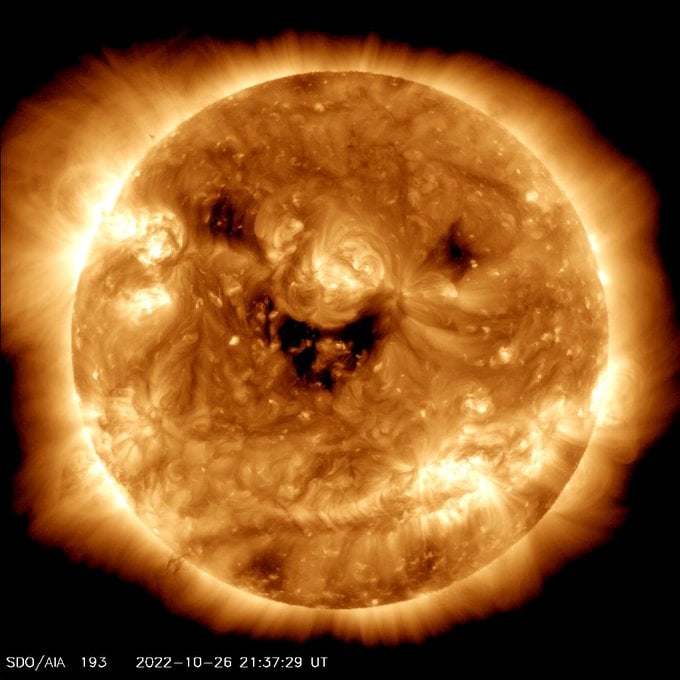Following Tuesday’s partial solar eclipse, the Sun developed a smiley face pattern. NASA shared the picture of the sun “smiling” on the official Twitter page of NASA Sun on Thursday. The image shows a face-like pattern made up of black patches on the Sun.
NASA Sun shared the incredible image with the caption: “Say cheese! Today, NASA’s Solar Dynamics Observatory caught the sun ‘smiling.’ Seen in ultraviolet light, these dark patches on the sun are known as coronal holes and are regions where fast solar wind gushes out into space.”

NASA’s Solar Dynamics Observatory, which is behind the image, is an agency mission aimed at investigating how solar activity is created and influences space weather. The agency was launched on February 11, 2010. The observatory’s spacecraft measures the sun’s interior, atmosphere, magnetic field, and energy output.
Viral image similar to that of a pumpkin, users say
Since NASA posted the image, it has garnered over fifteen thousand likes, more than five thousand retweets, and numerous reactions.
The truth is that the Sun is not actually smiling in the image. What’s really going on here is the phenomenon of pareidolia. The word derives from the Greek words pará (παρά, “beside, alongside, instead [of]”) and the noun eídōlon (εἴδωλον, “image, form, reflection”). The phenomenon is the tendency of perception where people can imagine seeing things like faces in random patterns.
It’s a trick of the mind, only this time it’s being played out on a stupendous, Sun-sized scale.
As some keen-eyed Twitter users have observed, the Sun’s visage here doesn’t only look like a smiling face.

The viral image prompted numerous comedic responses online with many comparing the image to a carved Halloween pumpkin, a lion, and the sun featured in the children’s popular TV show Teletubbies.
One user replied: “Is that the face of the Stay Puf[t] marshmallow man from Ghostbusters?”
“Obviously the sun is gonna be smiling after the eclipse!” one user jokingly said.
“I see two versions of the smiley, the large coronal hole is a nose and there is a curve to the swirls under it that is a mouth, or the large coronal hole is a cutesy mouth itself,” another user commented.
Potential solar storm
According to space experts, the picture of the Sun is not as happy as it looks. The dark patches which are seen in ultraviolet light are actually coronal holes, which are the regions where fast solar wind gushes out into space.
Scientists warn that the sun’s coronal holes may mean that a solar storm could be hitting Earth on Saturday night.
Spaceweather.com, a website that keeps track of all solar activities, said: “The cheerful mein [sic] is spewing a triple stream of solar wind toward Earth.”
The face-like pattern is a result of the coincidental positioning of these coronal holes, which are basically open magnetic field regions in the Sun’s atmosphere that are cooler and denser than the surrounding plasma.
Solar storms are a variety of eruptions of mass and energy from the solar surface. These eruptions deform the earth’s magnetic field. Consequently, these storms increase the visibility of the polar lights, the auroras in the northern and southern hemispheres.
VIDEO:





